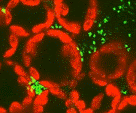Plant Pathology, Department of

Department of Plant Pathology: Faculty Publications
ORCID IDs
Rachel A. Koch
Joshua R. Herr
Document Type
Article
Date of this Version
2021
Citation
Koch RA, Herr JR. 2021. Transcriptomics reveals the putative mycoparasitic strategy of the mushroom Entoloma abortivum on species of the mushroom genus Armillaria. mSystems 6: e00544-21.
doi:10.1128/mSystems .00544-21.
Abstract
During mycoparasitism, a fungus—the host—is parasitized by another fungus—the mycoparasite. The genetic underpinnings of these relationships have been best characterized in ascomycete fungi. However, within basidiomycete fungi, there are rare instances of mushroom-forming species parasitizing the reproductive structures, or sporocarps, of other mushroom-forming species, which have been rarely investigated on a genetic level. One of the most enigmatic of these occurs between Entoloma abortivum and species of Armillaria, where hyphae of E. abortivum are hypothesized to disrupt the development of Armillaria sporocarps, resulting in the formation of carpophoroids. However, it remains unknown whether carpophoroids are the direct result of a mycoparasitic relationship. To address the nature of this unique interaction, we analyzed gene expression of field-collected Armillaria and E. abortivum sporocarps and carpophoroids. Transcripts in the carpophoroids are primarily from E. abortivum, supporting the hypothesis that this species is parasitizing Armillaria. Most notably, we identified differentially upregulated E. abortivum β-trefoil- type lectins in the carpophoroid, which we hypothesize bind to Armillaria cell wall galactomannoproteins, thereby mediating recognition between the mycoparasite and the host. The most differentially upregulated E. abortivum transcripts in the carpophoroid code for oxalate decarboxylases—enzymes that degrade oxalic acid. Oxalic acid is a virulence factor in many plant pathogens, including Armillaria species; however, E. abortivum has evolved a sophisticated strategy to overcome this defense mechanism. The number of gene models and genes that code for carbohydrate- active enzymes in the E. abortivum transcriptome was reduced compared to other closely related species, perhaps as a result of the specialized nature of this interaction.
IMPORTANCE By studying fungi that parasitize other fungi, we can understand the basic biology of these unique interactions. Studies focused on the genetic mechanisms regulating mycoparasitism between host and parasite have thus far concentrated on a single fungal lineage within the Ascomycota. The work presented here expands our understanding of mycoparasitic relationships to the Basidiomycota and represents the first transcriptomic study to our knowledge that examines fungal- fungal relationships in their natural setting. The results presented here suggest that even distantly related mycoparasites utilize similar mechanisms to parasitize their host. Given that species of the mushroom-forming pathogen Armillaria cause plant root-rot diseases in many agroecosystems, an enhanced understanding of this interaction may contribute to better control of these diseases through biocontrol applications.


Comments
Copyright © 2021 Koch and Herr. This is an open-access article distributed under the terms of the Creative Commons Attribution 4.0 International license.